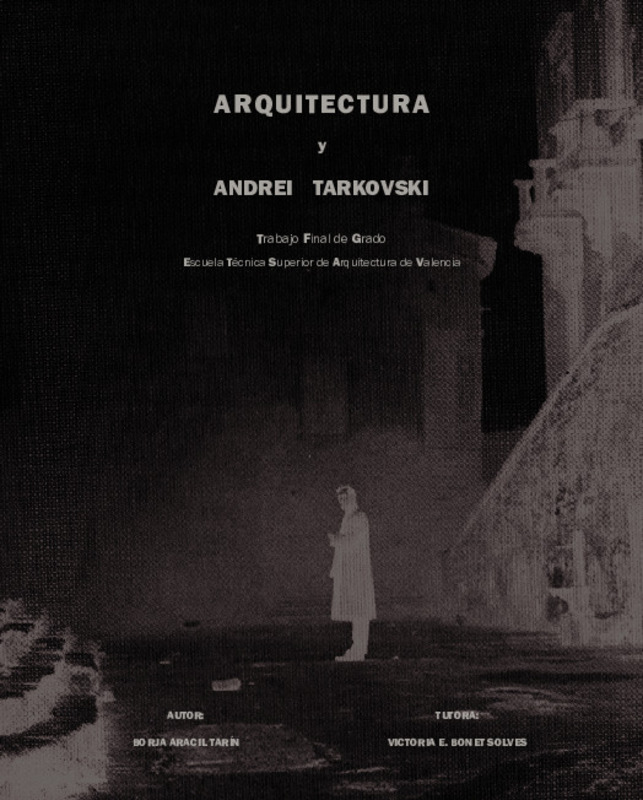JavaScript is disabled for your browser. Some features of this site may not work without it.
Buscar en RiuNet
Listar
Mi cuenta
Estadísticas
Ayuda RiuNet
Admin. UPV
Arquitectura y Andrei Tarkovski
Mostrar el registro sencillo del ítem
Ficheros en el ítem
| dc.contributor.advisor | Bonet Solves, Victoria Eugenia
|
es_ES |
| dc.contributor.author | Aracil Tarín, Borja
|
es_ES |
| dc.date.accessioned | 2017-12-11T13:02:58Z | |
| dc.date.available | 2017-12-11T13:02:58Z | |
| dc.date.created | 2016-09-15 | |
| dc.date.issued | 2017-12-11 | es_ES |
| dc.identifier.uri | http://hdl.handle.net/10251/92444 | |
| dc.description.abstract | Andrei Tarkovsky praised the architectural space providing a unique nature. The leading figure of the Russian director reminds us of the romantic artists at the 19th century. The Romantic Movement was born in a critical moment, as well as Tarkovsky¿s film was born in a period where leads movements were gone and humanity was much more materialistic and pragmatic than ever. The deepest interpretation that there is obtained from Tarkovsky¿s films has similarities with the current situation of the architect. We are lost between technical and artistic, materialism and spirituality. The task of this profession is the harmony between the two sides, but when spirituality and artistic are forgotten, everything falls apart. | es_ES |
| dc.description.abstract | Andrei Tarkovski alababa el espacio arquitectónico dotándolo de un carácter único. La figura del director ruso recuerda a la de los artistas románticos del s. XIX. El movimiento romántico nació en un momento de crisis, al igual que el cine de Tarkovski nace en una época donde los grandes movimientos han desaparecido y la humanidad es más materialista y pragmática que nunca. La profunda lectura que se obtiene de las películas de Tarkovski también llega a la situación del arquitecto hoy en día, perdido entre lo técnico y lo artístico, lo material y lo espiritual. La labor de este oficio se basa en el equilibrio de ambas partes, pero cuando lo espiritual y lo artístico se olvidan, todo se tambalea. | es_ES |
| dc.format.extent | 74 | es_ES |
| dc.language | Español | es_ES |
| dc.publisher | Universitat Politècnica de València | es_ES |
| dc.rights | Reserva de todos los derechos | es_ES |
| dc.subject | Soviet cinema | es_ES |
| dc.subject | Cine soviético | es_ES |
| dc.subject | Cine | es_ES |
| dc.subject | Cinema | es_ES |
| dc.subject | Andrei Tarkovski (director) | es_ES |
| dc.subject | Romanticism | es_ES |
| dc.subject | artist | es_ES |
| dc.subject | ruin | es_ES |
| dc.subject | space | es_ES |
| dc.subject | Romanticismo | es_ES |
| dc.subject | artista | es_ES |
| dc.subject | ruina | es_ES |
| dc.subject | espacio | es_ES |
| dc.subject.classification | COMPOSICION ARQUITECTONICA | es_ES |
| dc.subject.other | Grado en Fundamentos de la Arquitectura-Grau en Fonaments de l'Arquitectura | es_ES |
| dc.title | Arquitectura y Andrei Tarkovski | es_ES |
| dc.type | Proyecto/Trabajo fin de carrera/grado | es_ES |
| dc.rights.accessRights | Abierto | es_ES |
| dc.description.bibliographicCitation | Aracil Tarín, B. (2016). Arquitectura y Andrei Tarkovski. http://hdl.handle.net/10251/92444 | es_ES |
| dc.description.accrualMethod | TFGM | es_ES |
| dc.relation.pasarela | TFGM\40280 | es_ES |
Este ítem aparece en la(s) siguiente(s) colección(ones)
-
ETSA - Trabajos académicos [4812]
Escuela Técnica Superior de Arquitectura






